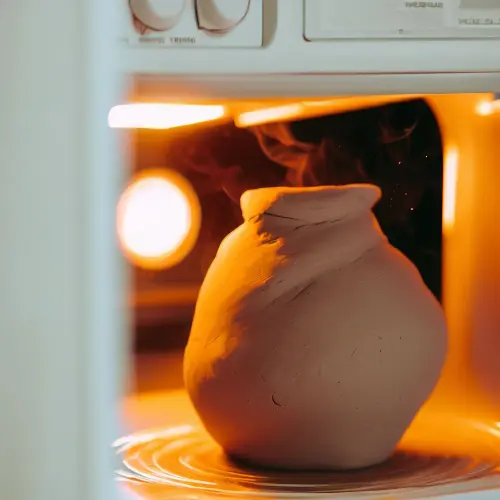Thekitchenkits.online is an Amazon Associate and earns from qualifying purchases made through affiliate links on our site at no extra cost to you. This supports our efforts to bring you valuable kitchen-related content.
Table of Contents
Can I Put Air Dry Clay In The Microwave
Putting air-dried clay in the microwave is generally not recommended. Air dry clay, also known as modeling clay, is a popular type of clay used by artists and hobbyists to create various crafts and sculptures. Unlike other clays that require firing in a kiln, air dry clay is designed to harden and cure at room temperature as it dries. This makes it very convenient to use.
However, air dry clay can take quite a long time to fully dry and harden. This often leaves crafters wondering if there is a way to speed up the drying process and make air-dry clay dry faster. A common question is whether you can dry air-dry clay in the microwave.
Drying Air Dry Clay Faster in the Microwave
Microwaving the clay can cause uneven heating and drying, which may lead to cracks and breakage. The rapid heating can also create air pockets or bubbles within the clay as moisture turns to steam.
However, it is possible to microwave air-dry clay for very short periods of time to help speed up the initial drying process. This can shave off some of the drying time and make the clay ready for handling or detailing faster.
Here are some tips for microwaving air dry clay:
- Microwave in short bursts – Only microwave air-dry clay for 10-20 seconds at a time. Longer shots can overheat the clay.
- Allow the clay to rest between bursts – This gives the heat time to evenly distribute through the clay and prevents localized overheating.
- Keep an eye on it – Check the clay frequently to make sure it is not becoming too hot or developing cracks.
- Let it finish air drying – Once the clay has firmed up, take it out and allow it to fully dry and cure through air drying.
- Avoid microwaving large or thick pieces – Larger and thicker clay pieces take longer to heat through and are more prone to cracking.
- Don’t microwave clay with internal armatures – The metal can overheat and damage the clay.
- Adjust microwave power – Use a lower power setting if available.
Is Microwaving Recommended for Air Dry Clay?
While microwaving in short bursts can help speed the initial firming, it is generally not recommended as the best or primary method for drying air clay. Air drying is still the safest way to get a smooth, even drying result.
Microwaving air dry clay comes with some risks:
- Uneven heating or drying
- Cracks and breakage
- Bubbles or air pockets in the clay
- Accidental overheating and scorching
Air drying takes more time but avoids these issues. Placing the clay in a warm, dry area allows moisture to evaporate slowly and evenly.
If speed is needed, there are some other alternatives to try:
- Use a drying box, food dehydrator or other enclosed warm area
- Use a portable space heater, blow dryer or fan to move air around the clay
- Place the clay next to a gently warming appliance like a television or computer
- Separate clay pieces to allow more surface exposure to air
Tips for Drying Air Dry Clay
Here are some tips to help dry air-dry clay efficiently:
- Work in thin layers – Thin clay sections will dry faster. For larger projects, build up thickness gradually.
- Allow good air circulation – Exposure to moving air accelerates drying time. Avoid enclosing clay in plastic too soon.
- Elevate pieces off the work surface – This allows air to circulate under and around the entire piece.
- Separate joined pieces – Dry construction seams separately, then assemble once dry.
- Start projects well in advance – Plan for air drying to take 24-48 hours or more to harden clay fully. Factor in extra lead time.
- Use a drying box – An enclosed box with gentle heat from a low-wattage bulb helps dry clay evenly.
- Do not attempt to rush drying – Patience prevents problems!
Can You Put Air Dry Clay in the Oven?
Putting air dry clay in a warm oven can help speed drying similar to a drying box. However, there are some important precautions:
- Keep oven temp very low – Do not exceed 200°F. Higher heat can damage clay.
- Leave oven door open – This allows moisture to escape and prevents overheating.
- Check frequently – Monitor clay closely to prevent cracks or scorching.
- Allow the clay to cool fully – Bring the clay back to room temperature before additional handling to prevent damaging compressed steam.
- Do not microwave and oven dry – This compounds the risks of uneven drying and moisture buildup.
- Be patient – Increase drying time gradually to find the sweet spot for your particular oven and clay type.
It is best to use the oven only for the initial stages of drying. Allow the clay to finish air drying normally for the last stages when the moisture content is lower.
Drying Air Dry Clay Without Heat
Patience is key when drying air dry clay without additional heat sources. Here are some tips:
- Work in thin layers – Thinner clay dries fastest when air drying.
- Allow adequate drying time – Drying can take 24 hours or more. Allow extra time for larger or thicker pieces.
- Elevate clay off the work surface – Raise pieces on supports to allow air circulation all around.
- Provide ample airflow – Position clay in an area with good cross ventilation and air movement. Avoid closing in plastic too early.
- Separate and spread out pieces – Individual pieces will dry faster than clay left in a solid block or mass.
- Rotate pieces periodically – Shift clay to expose all sides to air for even drying.
- Maintain ambient warmth – Air-dry clay dries best around 70°F. Cool, damp environments will prolong drying.
- Check clay frequently – Look for cracks or moist areas and increase air circulation as needed.
- Delay assembly – Join properly dried pieces for best results. Wet clay adheres to damp clay, but bonds poorly.
With proper planning and patience, air-dried clay provides the safest result free of cracking or damage from added heat sources.
FAQ
How long does it take air dry clay to dry?
Drying times vary by size, thickness, and climate. In general, air dry clay takes 24-48 hours to fully harden when air dried correctly in thin layers with good air circulation. Larger or thicker pieces may take longer.
How can I make air-dry clay dry faster?
Work in thin layers, allow ample airflow, use fans or drying boxes, avoid plastic wrapping too early, gently warm with appliances or low oven temperatures, and be patient. Do not microwave on high.
Can you put air-dry clay in the sun?
Direct sun can overheat and dry clay unevenly. Gentle daylight is fine, but avoid excessive heat buildup which could damage clay.
Does air-dry clay dry faster on a radiator?
Yes, placing clay pieces near a radiator or other low-level heat source can help accelerate drying compared to room-temperature air alone. Just monitor closely to avoid overheating.
Can you bake air-dry clay?
Air-dry clays are generally not intended to be kiln-fired at high temperatures like pottery clay. However, baking air clay at very low oven temperatures below 275°F can help to fully harden and strengthen pieces once fully air dried.
Why is my air dry clay taking so long to dry?
Excess moisture, inadequate ventilation, cool temperatures, large thick pieces, and enclosed plastic wrapping can slow drying times. Ensure proper conditions for curing.
Does air-dry clay dry from the outside in?
Yes, the drying process starts on the outer exposed surfaces and slowly works inwards as moisture evaporates towards the center of the clay body over time.
Conclusion
Air-dry clay offers convenience for crafting and clay modeling. While it can be tempting to speed the drying process using added heat, air drying is the recommended method to prevent cracking or damage. Microwaving air dry clay briefly can help firm up the clay but should be avoided for full drying.
Provide adequate warm, dry air exposure instead for best results and patience for this slow-drying medium. With proper care in drying and handling, air-dried clay can produce lasting creations.

I’m Ian Welkins, a seasoned professional in the kitchen industry. My passion now drives me to provide invaluable insights into the world of top-notch kitchen products. With years of hands-on experience, I’m your go-to source for culinary excellence.


